User Guidance Manual
Last updated in December 2011 for use with ADePT Design Builder version 1.3
© 2011 Adept Management Ltd. All rights reserved
�
�
CHAPTER 1: INTRODUCTION.............................................................................. 1
1.1 Welcome to ADePT ................................................................................ 1
1.2 Welcome to ADePT Design Builder .............................................................. 1
1.3 About this user manual ........................................................................... 2
1.4 The basics ........................................................................................... 2
CHAPTER 2: MANAGING A PROJECT FILE ............................................................... 4
2.1 Create a new blank model file .................................................................. 4
2.2 Create a new model file from an existing template......................................... 4
2.3 Open an existing model file ...................................................................... 5
2.4 Close a file .......................................................................................... 5
2.5 Save the model file you are working on ....................................................... 5
2.6 Save a model file under a new name .......................................................... 5
2.7 Append an existing model file to your current project file ................................ 5
2.8 Import a data table from MS Excel to a new model file .................................... 6
2.9 Export a model file to an MS Excel data table ............................................... 6
CHAPTER 3: SETTING UP A PROJECT ................................................................... 7
3.1 Rename your model or project within the file ............................................... 7
3.2 Assign responsibilities for modelling and managing the process model or file ......... 7
3.3 Set the project start date and reporting date ................................................ 7
3.4 Define project stages ............................................................................. 8
3.5 Define project team disciplines ................................................................. 9
3.6 Define organisations / companies responsible for aspects of the project ............... 9
3.7 Define the roles or people responsible for aspects of the project...................... 10
3.8 View the responsibilities assigned to activities in your model .......................... 10
3.9 Assign a day-rate to a responsibility ......................................................... 11
3.10 Set up a calendar for assignment to a responsibility in the project .................. 11
3.11 Assign a calendar to a responsibility ........................................................ 12
3.12 Add project documents to the model ...................................................... 12
3.13 Import project documents to the model ................................................... 13
3.14 Preview and print a report ................................................................... 13
CHAPTER 4: SETTING UP A WORK BREAKDOWN STRUCTURE (WBS) ............................. 15
4.1 Add a new WBS heading to a project model ................................................ 15
4.2 Rename a heading in the WBS ................................................................. 15
4.3 Delete a heading or branch from the WBS .................................................. 15
4.4 Move a heading or branch to a new location in the WBS ................................. 15
4.5 Drag and drop a heading or branch to a new location in the WBS ...................... 16
4.6 Copy a heading or branch of the WBS ........................................................ 16
4.7 Cut a heading or branch from the WBS and place it in a new position ................ 17
4.8 Copy multiple branches of the WBS at the same time ('advanced copy') .............. 17
4.9 Merge activities or a branch of the WBS into a heading .................................. 20
4.10 Add a new activity to a project model ..................................................... 20
4.11 Rename an activity in the WBS .............................................................. 21
4.12 Rename an activity in the project model .................................................. 21
© 2011, Adept Management Ltd
�
4.13 Delete an activity from the project model ................................................ 21
4.14 Move an activity to a new location in the WBS ........................................... 21
4.15 Drag and drop an activity to a new location in the WBS ................................ 22
4.16 Copy an activity in the project model ...................................................... 22
4.17 Cut an activity and position it in a new position. ........................................ 22
4.18 Create a duplicate of an activity in the WBS (split) ..................................... 23
4.19 Find & replace a word or term within a branch of the WBS ............................ 24
CHAPTER 5: DEFINING THE CHARACTERISTICS OF ACTIVITIES .................................... 25
5.1 Assign a duration to an activity ............................................................... 25
5.2 Create a new responsibility and assign it to an activity .................................. 25
5.3 Assign an existing responsibility to an activity ............................................. 25
5.4 Add a description to an activity ............................................................... 26
5.5 Assign an activity as a milestone.............................................................. 26
5.6 Assign an activity as ‘highlighted’ for special attention .................................. 26
5.7 Assign progress (% complete) to an activity ................................................. 26
5.8 Assign a time constraint to an activity ....................................................... 27
5.9 Assign effort to an activity ..................................................................... 27
5.10 Assign an activity category to an activity .................................................. 27
5.11 Assign a project stage to an activity ........................................................ 28
5.12 Assign an activity property to all the activities in a WBS branch ...................... 28
5.13 Set up and associate ‘codes’ with activities .............................................. 28
CHAPTER 6: DEFINING ACTIVITY DEPENDENCIES .................................................... 30
6.1 Add dependencies and predecessors to an activity ........................................ 30
6.2 Add a single dependency and predecessor to an activity ................................ 32
6.3 Add a new output and successor to an activity ............................................ 32
6.4 Add a new output from an activity ........................................................... 32
6.5 Link an activity's existing output to successor activities ................................. 33
6.6 Rename an output from an activity .......................................................... 33
6.7 Change a dependency classification .......................................................... 34
6.8 Change a dependency type .................................................................... 34
6.9 Allocate lag to a dependency between two activities .................................... 34
6.10 Remove an output and all associated successors from an activity .................... 35
6.11 Remove a successor activity, whilst leaving the associated output in place ........ 35
6.12 Remove a dependency and the related predecessor from an activity ................ 35
6.13 Associate an existing project document with an activity output ...................... 36
6.14 Add a new project document and assign it to an activity output ..................... 36
6.15 Remove a project document from an activity output ................................... 37
CHAPTER 7: WORKING WITH A PROJECT MATRIX ................................................... 38
7.1 View the project matrix ........................................................................ 38
7.2 Pan around the project matrix ................................................................ 38
7.3 Zoom in or out of the matrix view ............................................................ 38
7.4 View dependencies, information and predecessor on the matrix ....................... 39
7.5 Add dependencies between activities directly on the matrix view..................... 39
© 2011, Adept Management Ltd
�
7.6 Edit dependencies between activities directly on the matrix view .................... 39
7.7 Remove dependencies between activities directly on the matrix view ............... 39
7.8 Observe whether predecessors and successors are ‘Driving’ and/or ‘Critical’ ....... 39
CHAPTER 8: ANCHORING ACTIVITIES IN A MATRIX .................................................. 41
8.1 Lock / unlock activities in position in the process sequence (anchoring) ............. 41
8.2 Move an activity in the optimised process sequence ...................................... 41
8.3 View locked activities and any resulting implied iterative blocks of activities ...... 42
8.4 Tear locked activities / dependencies to avoid new iterative blocks of activities .. 42
CHAPTER 9: OPTIMISING AND TEARING A MATRIX .................................................. 44
9.1 Optimise the activity sequence in the matrix .............................................. 44
9.2 Identify and resolve ‘out-of-sequence progress’ ........................................... 44
9.3 Place activities in the matrix in the order they appear in the WBS .................... 46
9.4 View details of all iterative blocks in the optimised process ............................ 46
9.5 Amend the combined duration of activities in an iterative block....................... 47
9.6 Tear the dependencies in an iterative block of activities ................................ 47
9.7 Preview the effect of tearing dependencies in an iterative block of activities ...... 49
9.8 View a record of all tears made (tear history) ............................................. 50
9.9 Copy a record of all tears made (tear history) to a third-party application .......... 50
9.10 Observe start and end dates of activities .................................................. 50
9.11 Observe whether an activity has any float or is on the project’s Critical Path ..... 51
9.12 Observe whether an activity’s dates comply with an assigned time constraint .... 51
CHAPTER 10: CREATING OR UPDATING A BAR CHART ............................................. 53
10.1 Generate a new Asta Power Project bar chart from a model file ..................... 53
10.2 Generate a new Microsoft Project bar chart from a model file........................ 55
10.3 Generate a new Primavera bar chart from a model file ................................ 57
10.4 Update an existing Asta Power Project bar chart from a model file .................. 60
10.5 Update an existing Microsoft Project bar chart from a model file .................... 61
10.6 Update an existing Primavera bar chart from a model file ............................. 62
10.7 Update a model file from an Asta Power Project bar chart ............................ 63
10.8 Update a model file from a Microsoft Project bar chart ................................ 63
10.9 Update a model file from a Primavera bar chart ......................................... 64
© 2011, Adept Management Ltd
�
CHAPTER 1: INTRODUCTION
1.1 Welcome to ADePT
Many programme over-runs and cost over-spends in complex projects are the result of
design and engineering teams working with poorly co-ordinated design information. The
‘ADePT’ technique and associated ADePT Design software suite are used to develop
integrated design plans which ensure that designers are able to work together to generate
a fully co-ordinated design.
ADePT is a highly structured approach to planning, and subsequently managing, the design
activities within a complex project. The approach is aimed at development of a design plan
which is fully integrated across the design team members and based on the critical flows of
information between them. Subsequent management of information flows is regarded as a
much better way of controlling the design process than simply monitoring production of
deliverables or rate of fee spend. There are three stages to planning with ADePT, and a
further management stage.
ADePT identifies a sequence of activities which minimises the iteration in the design
process and ensures any assumptions which the team need to make are ones which can be
made with confidence. This is achieved by weighting the dependencies between activities.
The calculation of a sequence prioritises the availability of outputs associated with the
most critical dependencies. Any interdependent, iterative groups of activities which
remain in the process following sequencing are often multi-disciplinary. They represent
places in the design process where design team members should work concurrently to solve
the interdependent problem. Usually they also represent elements of the product, and
therefore of the design output, which require co-ordination.
Having produced a target design plan, the design process needs to be controlled. ADePT
incorporates an approach to process control which pre-empts deviation from the target
schedule by analysing constraints, which then allows the plan to be kept up-to-date and
used in meaningful way.
In Summary, the ADePT methodology and the ADePT Design software suite provides a
means of planning, managing and controlling the delivery of a project on the basis of co-
ordinated interdisciplinary working. There are many benefits to decision-makers from
utilising this approach: the number of assumptions that cannot be made with confidence is
minimised; risk and cost implications can be understood and subsequently managed;
wasteful iteration can be eliminated; and focus can be given to taking interconnected
decisions quickly and effectively. Ultimately, the approach offers a means of planning,
controlling, and managing projects in an informed, coherent, and achievable manner.
1.2 Welcome to ADePT Design Builder
© 2011, Adept Management Ltd
Page 1
�
ADePT Design Builder enables Project Managers, Design Managers and Planners to
implement the planning stages of the ADePT technique.
Defining a Work Breakdown Structure (WBS)
Complex iterative design and development processes can be planned by:
•
•
•
•
Defining the relationships between activities (dependencies)
Defining the properties of activities in the process
Establishing the optimal sequence through the process, identifying iteration and key
decisions at the same time
Ensuring that key milestone dates are achievable
Breaking down iterative aspects of the process into manageable elements (tearing)
•
•
•
Planned processes can then be monitored and controlled using ADePT Design Manager.
Creating a bar chart representation of the process
1.3 About this user manual
This user manual describes how each item of functionality in ADePT Design Builder is
accessed and executed. Each section covers the reasons for the functionality (why), how it
is executed, including any alternative methods (how), and any additional information. The
document has been deliberately kept brief (for a user manual), with each section being
presented as a series of brief steps supported by screen shots where necessary.
Each section can be read in isolation however the manual is laid out in the order that users
should logically follow the functionality of the software, mirroring the steps of the ADePT
methodology which the software enables. Therefore the user manual can also be used as a
tutorial if necessary (although specific tutorial material is available).
It is recommended that this user manual is used as a reminder, when needed, of the
functionality in the software and that initial familiarisation with the software is achieved
through the training which is available.
1.4 The basics
Before using this user manual it might be useful to familiarise yourself with the general
layout of the software and the terms which are used throughout the manual which relate
to layout.
Firstly, the product adopts the latest layout advocated by Microsoft office products, which
means that the File menu is not immediately obvious. It can be found by clicking on the
circle containing the product icon at the top-left hand corner of the application.
This style of layout works by selecting the appropriate ‘tab’ which in turn provides access
to the tools required for the functionality being used. Sometimes you will need to select
the correct tab and other times the tab will be selected automatically as you navigate
through the software. There are six tabs in ADePT Design Builder: Edit Activities, View
Sequence, Edit Blocks, View Information, View Documents and View Codes.
This layout means that useful functions like Save, Undo and Redo, Navigate Back and
Forward, and Help (denoted by a question mark) are all available without the need to
select a drop-down menu.
© 2011, Adept Management Ltd
Page 2
�
Finally, when working in a Work Breakdown Structure (WBS) or activities, the screen is split
into two at all times, with the left-hand pane representing the WBS and the right-hand
pane representing either the current WBS branch or details of an activity, depending on
what is selected in the WBS. The terms WBS Tree view, WBS Detail view and Activity Detail
view are used:
© 2011, Adept Management Ltd
Page 3
�
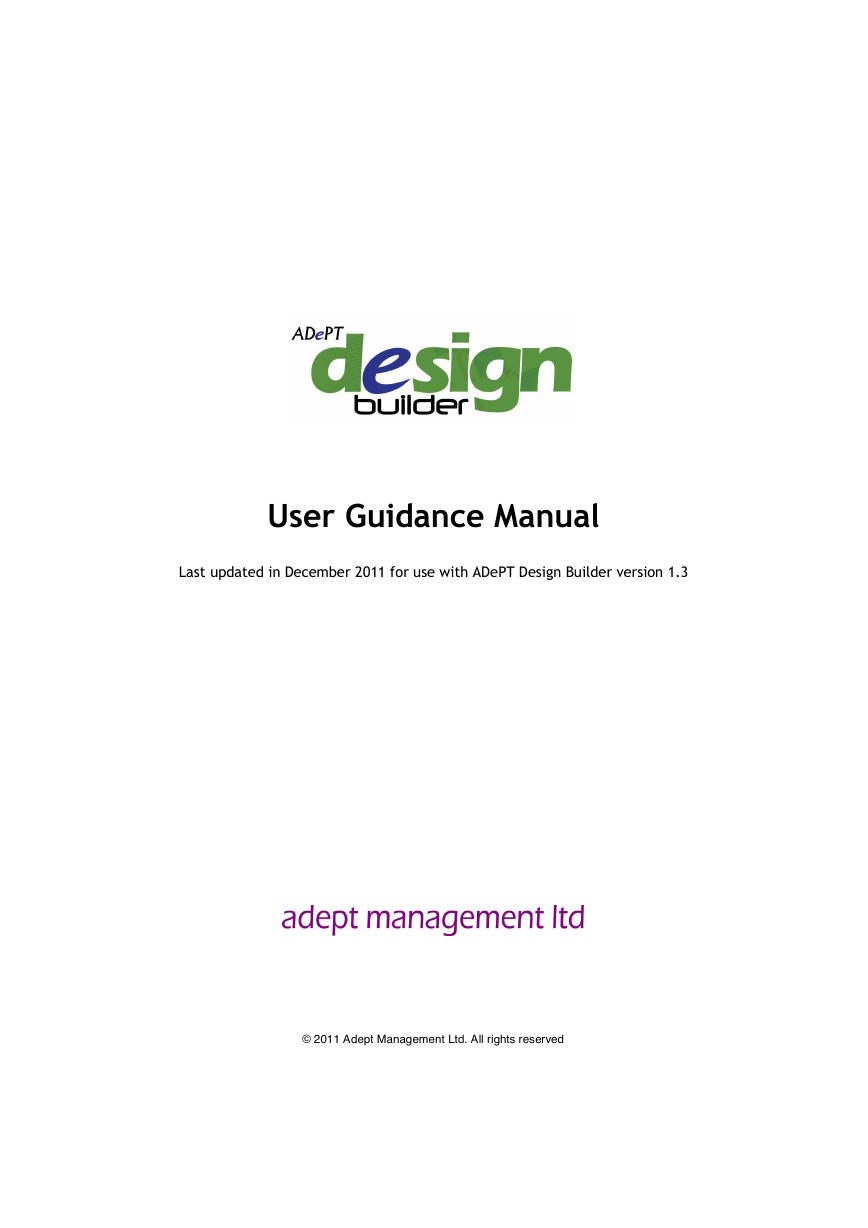


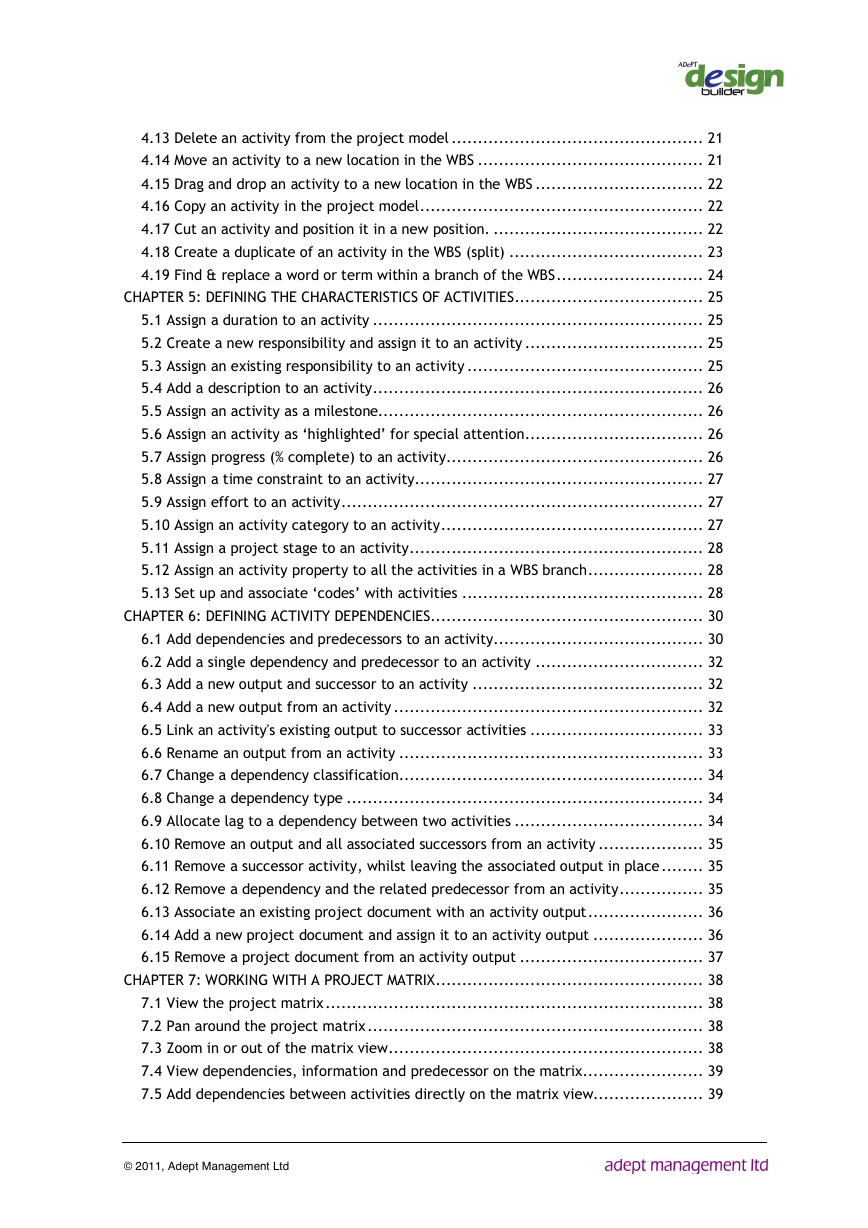

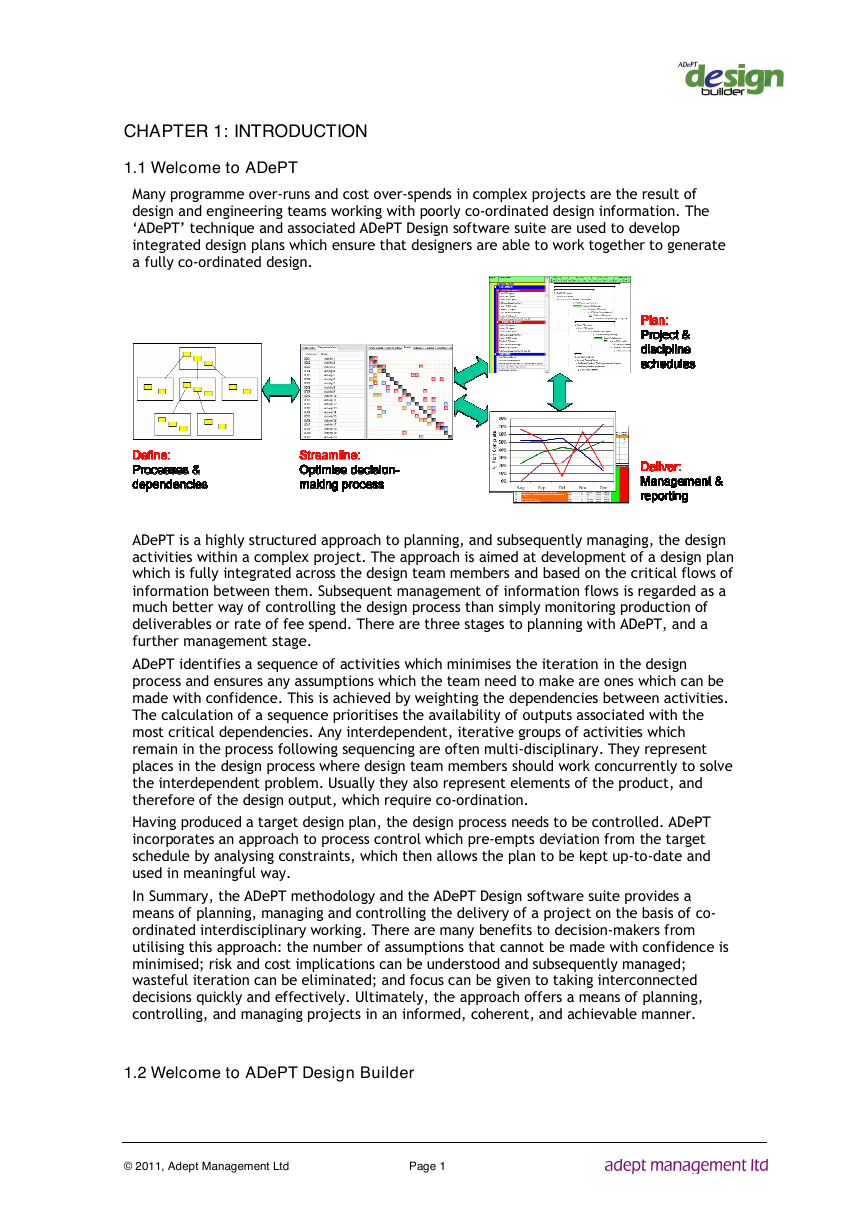
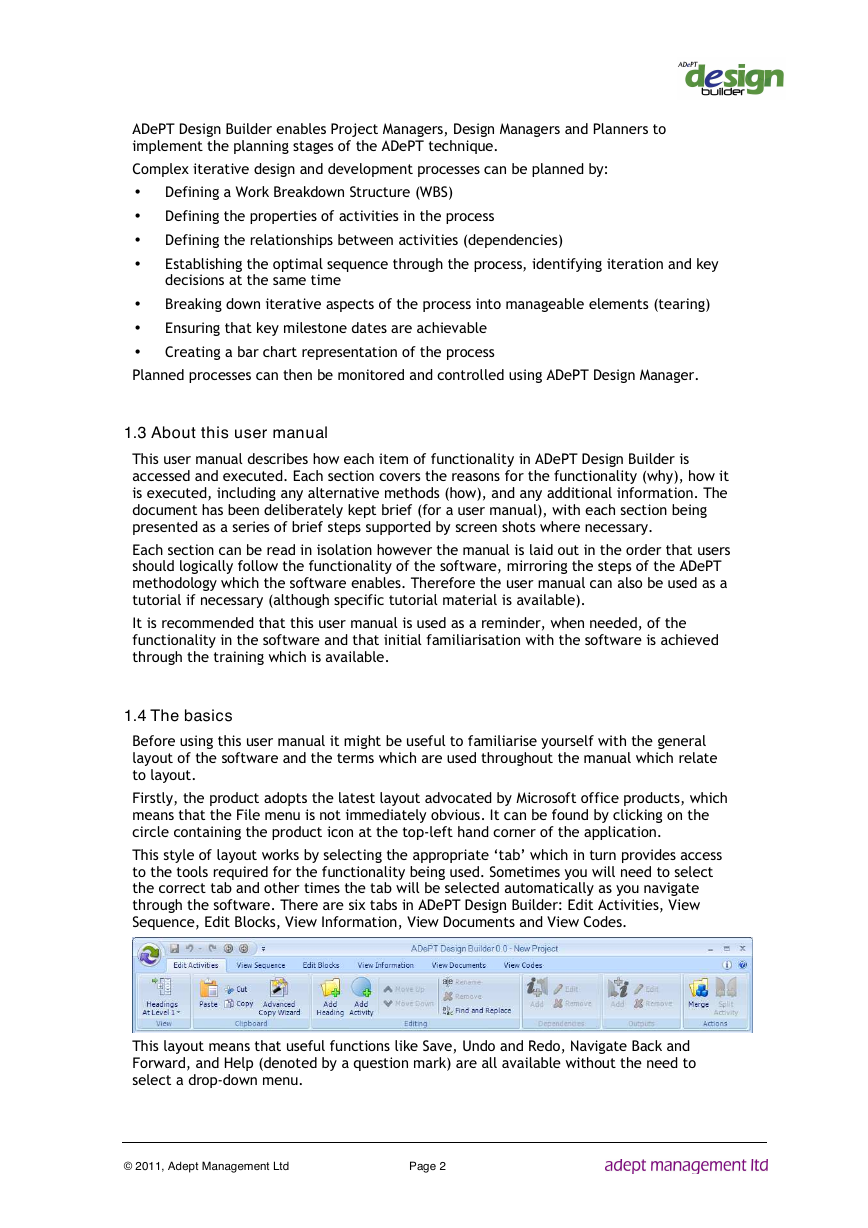
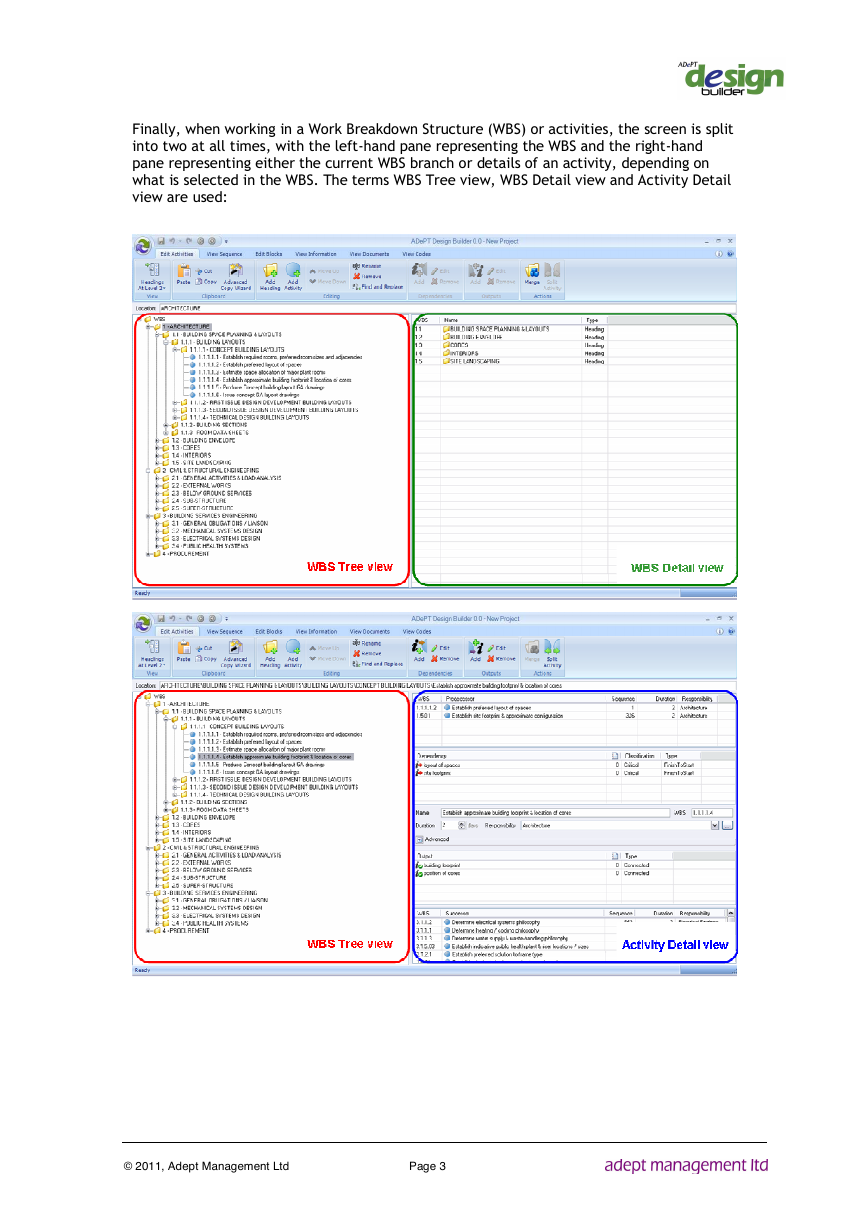








 2023年江西萍乡中考道德与法治真题及答案.doc
2023年江西萍乡中考道德与法治真题及答案.doc 2012年重庆南川中考生物真题及答案.doc
2012年重庆南川中考生物真题及答案.doc 2013年江西师范大学地理学综合及文艺理论基础考研真题.doc
2013年江西师范大学地理学综合及文艺理论基础考研真题.doc 2020年四川甘孜小升初语文真题及答案I卷.doc
2020年四川甘孜小升初语文真题及答案I卷.doc 2020年注册岩土工程师专业基础考试真题及答案.doc
2020年注册岩土工程师专业基础考试真题及答案.doc 2023-2024学年福建省厦门市九年级上学期数学月考试题及答案.doc
2023-2024学年福建省厦门市九年级上学期数学月考试题及答案.doc 2021-2022学年辽宁省沈阳市大东区九年级上学期语文期末试题及答案.doc
2021-2022学年辽宁省沈阳市大东区九年级上学期语文期末试题及答案.doc 2022-2023学年北京东城区初三第一学期物理期末试卷及答案.doc
2022-2023学年北京东城区初三第一学期物理期末试卷及答案.doc 2018上半年江西教师资格初中地理学科知识与教学能力真题及答案.doc
2018上半年江西教师资格初中地理学科知识与教学能力真题及答案.doc 2012年河北国家公务员申论考试真题及答案-省级.doc
2012年河北国家公务员申论考试真题及答案-省级.doc 2020-2021学年江苏省扬州市江都区邵樊片九年级上学期数学第一次质量检测试题及答案.doc
2020-2021学年江苏省扬州市江都区邵樊片九年级上学期数学第一次质量检测试题及答案.doc 2022下半年黑龙江教师资格证中学综合素质真题及答案.doc
2022下半年黑龙江教师资格证中学综合素质真题及答案.doc